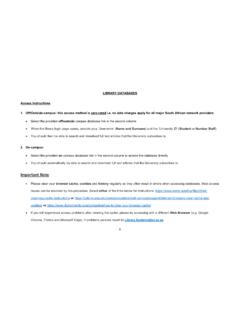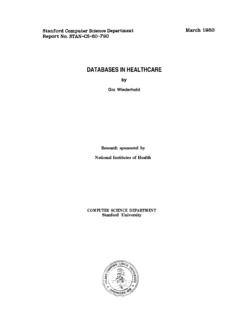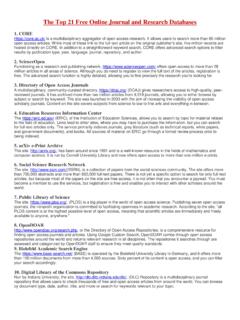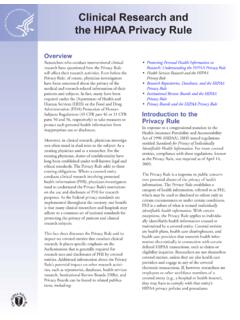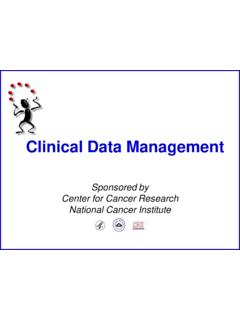Transcription of Clinical and Translational Science Institute / CTSI
1 Clinical and TranslationalScience Institute / CTSIat the University of California, San FranciscoAdverse Events in Clinical Trials:Definitions and DocumentationWelcome to Online Training for Clinical research Coordinators1 Monday, February 3, 14 Recognize the difference between a non-serious adverse event and Serious Adverse Events (SAEs). Recognize a Suspected Adverse Reaction Recognize Unexpected or Unanticipated Adverse Events Differentiate between Severity and Serious Adverse Events Understand Documentation Best PracticeObjectives2 Monday, February 3, 14 Protecting safety is a Federal mandate requiring investigators to report certain adverse events (see investigator commitments on FDA form 1572).
2 Terminology used in this module are derived from-FDA 21 Code of Federal regulations, -Safety Reporting Requirements for INDs and BA/BE Studies FDA Guidance, December 2012-International Conference of Harmonization ICH E-6 Good Clinical Practices Protecting safety is an institutional mandate from the UCSF CHR/IRB. Safety is often one of the protocol objectives when testing new therapies so adverse event data must be collected and reviewed by the Principal Investigator. Stopping rules are often clearly identified in terms of types and frequency of SAE s; the risk versus benefit ratio is a key variable on whether enrollment to a study can Beginning, Let s Review Principles of Subject Safety3 Monday, February 3, 14 Definitions of Adverse Events4 Adverse'event'means'any'untoward'medical 'occurrence'associated'with'the'use'of'a 'drug'in'humans,'whether'or'not'consider ed'drug'related.
3 ''21 CFR (a) Monday, February 3, 14 Definitions of Adverse EventsICH E6 Section An adverse event (also referred to as an adverse experience) can be any unfavorable and unintended sign ( , an abnormal laboratory finding), symptom, or disease temporarily associated with the use of a drug, without any judgment about causality or relationship to the drug. An adverse event can arise from any use of the drug ( , off-label use, use in combination with another drug) and from any route of administration, formulation, or dose, including an overdose. Monday, February 3, 14 Definitions of Adverse Events6 Indicates a change in the subject s health status since baseline right before taking the study drug.
4 When toxicity of the study drug is a hypothesis, you will see on the calendar, a baseline physical exam to be completed either at Day 0 or Day -5 prior to , February 3, 14 Definitions of Adverse Events7 Baseline would include all of the below: Pre-existing conditions that are ongoing during the Clinical trial-Hypertension-Diabetes Concomitant medications taken prior to participation in the Clinical trial-Anticoagulants to prevent thrombosis-Steroids for autoimmune conditionMonday, February 3, 14 Definitions of Adverse Events8 Examples of Adverse Events which are not related to [or caused by] the study drug but if they occur while the subject is on study, would have to be collected, reviewed by PI and tracked.
5 -Transfusion reactions-Accidental injuries-SurgeryMonday, February 3, 14 Definitions of Adverse Reaction9 A suspected adverse reaction means any adverse event for which there is a reasonable possibility that the drug caused the adverse event. Reasonable possibility means there is evidence to suggest a causal relationship between the drug and adverse , February 3, 14 Definition of a Serious Event or Serious Suspected Adverse Reaction21 CFR (a)10 An adverse event or suspected adverse reaction is considered "serious" if, in the view of either the investigator or sponsor, it results in any of the following outcomes.
6 Death, a life-threatening adverse event, inpatient hospitalization or prolongation of existing hospitalization, a persistent or significant incapacity or substantial disruption of the ability to conduct normal life functions, or a congenital anomaly/birth , February 3, 14A Life Threatening Adverse Drug Experience Defined11 Any adverse experience that places the subject, in the view of the investigator, at immediate risk of death from the reaction as it occurred, or it is suspected that the use or continued use of the product would result in the patient s death. Examples include: hemorrhaging and internal bleeding with rapid drop in blood pressure; Loss of consciousness from increase in pressure on the brainMonday, February 3, 14 Hospitalization Defined12 Admission to the hospital for longer than 24 hours or prolonga5on of a hospital stay due to adverse , February 3, 14 Disability Defined13 A substantial disruption of a person s ability to conduct normal life functions.
7 Examples include: loss of speech; fatigue so great the subject cannot get out of bed at all; loss of memory; and , February 3, 14 Congenital Anomaly Defined14 Exposure to a medical product prior to conception or during pregnancy resulting in an adverse outcome in the is the best exampleof a drug causing congenital anomalies with babies born with deformed arms and legs. Monday, February 3, 14 Definition of a Serious Event or Serious Suspected Adverse Reaction15 One final outcome that makes an event or reaction serious: Important medical events that may not result in death, be life threatening, or require hospitalization may be considered a serious adverse drug experience when, based upon appropriate medical judgment, they may jeopardize the patient or subject and may require medical or surgical intervention to prevent one of the outcomes listed in this CFR (a)
8 Monday, February 3, 14 Examples of Important Medical Events16 Allergic bronchospasm requiring intensive treatment in an emergency room or at home Blood dyscrasias Convulsions that do not result in inpatient hospitalization, Development of drug dependency or drug abuse. Monday, February 3, 14 What is Expected versus Unexpected when Defining Adverse Events or Suspected Adverse Reactions17 Expected toxicities from the study drug if found in the following: Safety information on approved products is reflected in product labeling (Package Insert) Up-to-date safety information on the products under investigation is found in the Investigator s Brochure (IB) From these sources the protocol and the informed consent is written to explain to describe what risks we currently expect from this study drug.
9 Safety profile of other drugs in the same classUnexpected means that the event experienced by the subject is not listed in any of the documents , February 3, 14 Definition of an Unexpected Adverse Event18 Unexpected: An adverse event or suspected adverse reaction is considered "unexpected" if it is not listed in the investigator brochure or is not listed at the specificity or severity that has been observed; or, if an investigator brochure is not required or available, is not consistent with the risk information described in the general investigational plan or elsewhere in the current application, as CFR (a)Monday, February 3, 14 Examples of an Unexpected Adverse Event19 Hepatic necrosis would be unexpected (by virtue of greater severity) if the investigator brochure only referred to elevated hepatic enzymes or hepatitis.
10 Cerebral thromboembolism and cerebral vasculitis would be unexpected (by virtue of greater specificity) if the investigator brochure only listed cerebral vascular accidents Monday, February 3, 14 Definition of Severity vs. Serious20 Refers to the intensity of the event and can be used with any event, without regard to whether or not it meets the federal criteria for serious ..is expressed in grades of severity. Responsibility of the principal investigator to concur with all intensity assessments added to the database for the events identified in the subject. Monday, February 3, 14 Examples of Grading Severity/Intensity Ranges21 Grade 1: Asymptomatic or mild symptoms; Clinical or diagnostic observations only; no intervention indicated Grade 2: Moderate; minimal, local or noninvasive intervention indicated; limiting age-appropriate instrumental ADL Grade 3: Severe; or medically significant but not immediately life- threatening; hospitalization or prolongation of hospitalization indicated; disabling; limiting self care ADL Grade 4: Life-threatening ; urgent intervention indicated.


